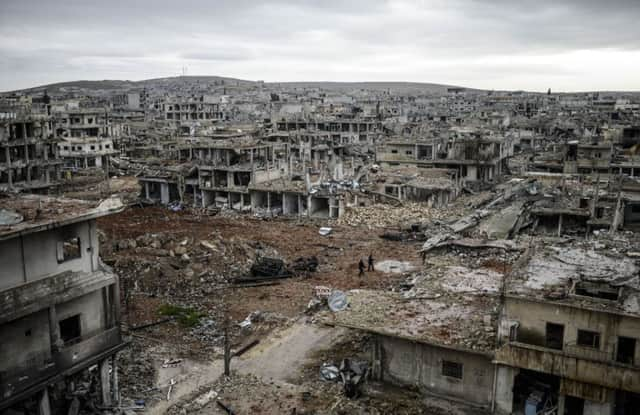Lawyers scour Kobane for evidence of IS war crimes


They have seen many pieces of unexploded ordnance from Islamic State, the militia group that lost the battle for this town last week.
Not a shop in the street has its windows or shutters intact. Four months of street fighting have punched holes in every building in this Syrian town on the Turkish border. But unlike a town after an earthquake, one does not see relief teams hurrying along to distribute food and blankets, and restore power lines.
Advertisement
Hide AdAdvertisement
Hide AdInstead one sees roadblocks made of wrecked cars. Sheets hung across the street to block the view of snipers. And occasionally the corpses of IS fighters, abandoned where they fell.
Like a runner after a marathon, Kobane is exhausted. The town, known as Ayn al-Arab in Arabic, is catching its breath. Kurdish lawyers from Diyarbakir, Turkey, visited on Friday. Their leader, Tahir Elci, said they had to come to collect evidence of war crimes, testimony that “one day would allow the perpetrators to be prosecuted in an international court”.
For that reason the Kurds have not removed two blue gas canisters lying in the rubble around Liberation Square. Perhaps filled with explosives, they are suspected booby traps.
The roundabout of Liberation Square is an island in a sea of devastation. Its statue of an eagle, painted in the garish yellow, red and green of the Kurdish flag, is almost the highest object standing.
During the battle, whenever the Kurdish fighters, the YPG, got into difficulties, they called in the coalition air force. Fighter-bombers would blast the designated IS-held building.
Technically this is called precision bombing, but on the ground it looks more like the carpet bombing of the Second World War. Whole neighbourhoods have been reduced to rubble.
One of the fighters’ press guides, Perwer Mohammed Ali, said the heaviest damage in Kobane was inflicted by their main ally, the coalition air force. To drive IS out of the town, they had to destroy it.
Consequently, few of the tens of thousands of refugees in Turkey are returning to Kobane today. In 2004, the town had a population of 45,000, according to the Syrian census bureau. A YPG fighter estimated the population is now 1,000 to 2,000.
Advertisement
Hide AdAdvertisement
Hide Ad“We are not asking for civilians to come back,” said Idris Nassan, the spokesman for Kobane’s leadership, “only the young who can fight and rebuild”.
A female fighter said their food came from the Kurds in Turkey. Turkey controls access to Kobane, carefully monitoring the quantities of food, arms and civilians that are allowed to cross.
“The international community must open a corridor to allow civilians to return from Turkey, and to allow food and medicine,” Nassan said
He was actually saying, politely, that Turkey must allow a free flow of people and goods across the border.
And that raises a political problem. The Kurds of Syria aspire to autonomy like that of the Kurdish Regional Government in Iraq.
Turkey is opposed to autonomy for Syrian Kurds for fear it would embolden Turkish Kurds to demand the same.
Another problem is that IS holds the west, south and east of Kobane. In Liberation Square, one hears the sound of IS tank shells exploding as the war continues in villages only 10km away.
The military commander of Kobane, Ismet Sheik Hassan, is confident his forces will win the battle for the adjacent villages. There, the enemy cannot fight building by building as they did in the streets of Kobane, he said.
Advertisement
Hide AdAdvertisement
Hide AdBut beyond those villages, IS rules a huge swathe of northern Syria – all the way to Raqqa, 100km to the south-east, and Aleppo, 160km to the south-west.
IS can strike back. After being ousted last week, it shelled the town’s perimeter, killing one person and wounding four.
Like the mortar bomb embedded in the Tarmac, Kobane is still precarious.